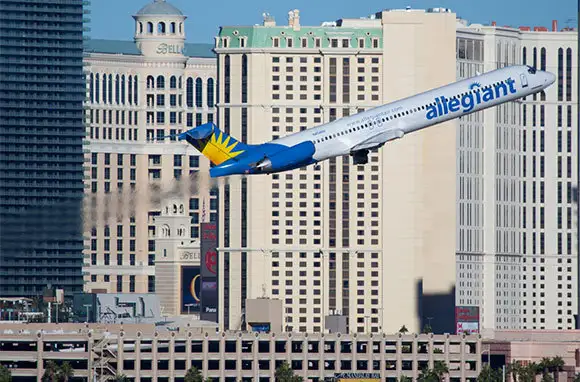
“You gotta have a gimmick.” That advice from the famous showstopping scene in the musical Gypsy was meant for strippers, but it applies to airlines as well. These days, to succeed, a small airline needs a distinct niche. It’s the old “find a need and fill it” rule, and “need” typically means a service that the giant lines are not providing. Here are eight North American airlines that seem to have each found their niche.
(Seat measurements were found on SeatGuru.)
Image Gallery
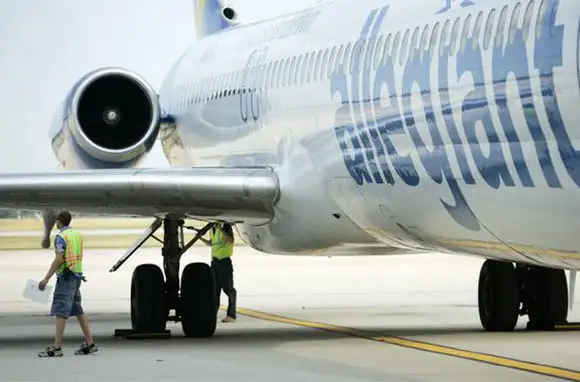
Allegiant: Big-Time Service to Small-Time Markets
Allegiant's very successful formula is to fly mainline jets a few times a week nonstop from small-town USA to blockbuster-destination USA. Base fares start out very low, but the line specializes in adding hotel or car packages so that the total revenue includes a lot more than the airfare alone. It currently flies mostly MD-80s but has recently added 757s and A319s.
Blockbuster destinations in the East include Ft. Lauderdale, Punta Gorda, Orlando/Sanford, St. Petersburg, and Myrtle Beach; western focus cities include Las Vegas, Los Angeles, Mesa/Phoenix, Oakland, Palm Springs, and San Diego on the mainland, plus Honolulu and Kahului. Most competing regional airlines at Allegiant's originating cities offer only feeder flights to their closest hubs, which translates to high fares and inconvenient schedules.
Allegiant's product is very low-end: tight seating and extra fees for almost everything. But to many leisure travelers in remote originating cities, it's the only game in town.

Allegiant: Big-Time Service to Small-Time Markets
Allegiant's very successful formula is to fly mainline jets a few times a week nonstop from small-town USA to blockbuster-destination USA. Base fares start out very low, but the line specializes in adding hotel or car packages so that the total revenue includes a lot more than the airfare alone. It currently flies mostly MD-80s but has recently added 757s and A319s.
Blockbuster destinations in the East include Ft. Lauderdale, Punta Gorda, Orlando/Sanford, St. Petersburg, and Myrtle Beach; western focus cities include Las Vegas, Los Angeles, Mesa/Phoenix, Oakland, Palm Springs, and San Diego on the mainland, plus Honolulu and Kahului. Most competing regional airlines at Allegiant's originating cities offer only feeder flights to their closest hubs, which translates to high fares and inconvenient schedules.
Allegiant's product is very low-end: tight seating and extra fees for almost everything. But to many leisure travelers in remote originating cities, it's the only game in town.
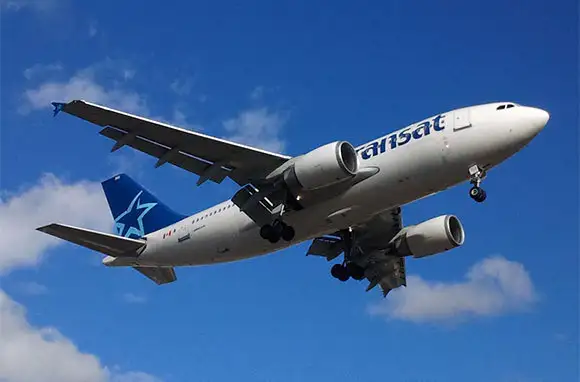
Air Transat: Low-Fare Deals from Canada
Air Transat, a subsidiary of one of Canada's largest tour operators, also sells flights separately. It's the only low-fare airline based in North America offering flights to Europe, and it also has a lot of service from major Canadian cities to sun-sand-surf destinations in Florida, the Caribbean, Mexico, and northern South America. Schedules are highly seasonal—big to Europe in the summer, big to beach centers in the winter.
Air Transat's product is low-end, especially flights on its A310s and A330-200s (the A330-300s are better), which are outfitted with ultra-narrow nine-across seating (worse than even 737s). Don't buy a regular economy ticket on these flights unless the fare is substantially less than fares on competitive lines. Air Transat also offers a premium-economy option that is considerably better and, of course, more expensive.
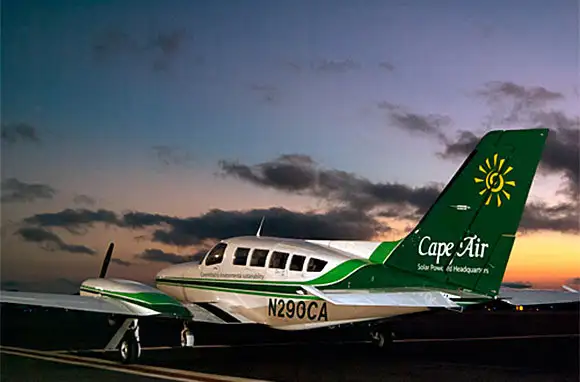
Cape Air: Wherever We Can Make a Buck
Cape Air has found not one but five different niches. Its main focus is an extensive route system centered on Boston, serving 13 mostly small cities in the Northeast, from White Plains (for the New York City area) to Massena (in upper New York state) to Maine, and of course—as Cape Air also operates as "Nantucket Airlines"—key points on Cape Cod, Martha's Vineyard, and Nantucket. Other routes include Puerto Rico to several nearby islands; Ft. Myers to Key West; St. Louis to a handful of smaller cities in Illinois, Kentucky, and Missouri; and Guam to Saipan and Rota.
Many routes are flown as codeshares with American, JetBlue, or United. Most flights are in small piston-powered Cessna twin-engine 402s, with a few in ATR 42 turboprops.
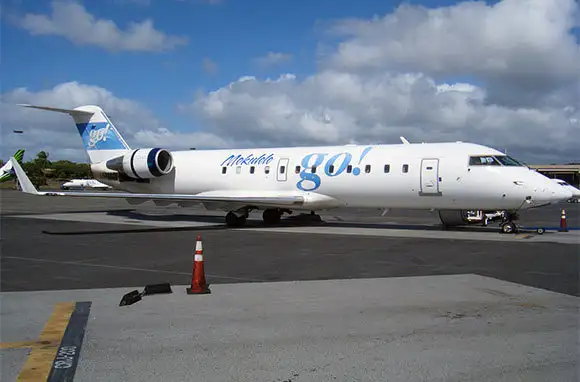
Go!: Hawaii's Second Airline
Since Aloha Airlines disappeared, Go! is the chief interisland competition for Hawaiian Airlines. In addition to serving the main points, it flies to some of the Islands' smaller tourism centers: Maui's Hana and Kapulua, as well as Lanai and Molokai. It uses a variety of promotions to compete with Hawaiian, such as mileage bonuses and no-charge same-day standby, and it also tries to keep fares competitive or better. Flights are in CRJ-200 regional jets and a few Grand Caravan single-engine turboprops.
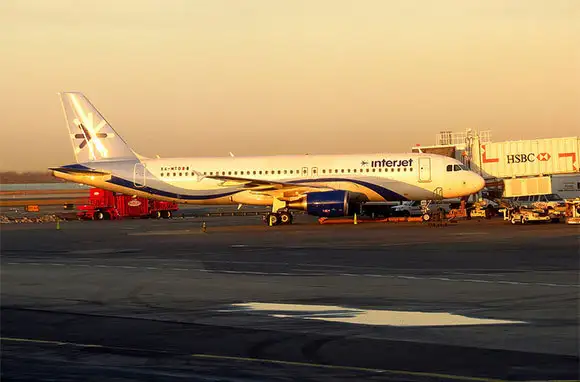
Interjet: Mexico's Quality Option
Imagine a low-fare line offering a generous 34-inch seat pitch on A320s, no-charge checked baggage (one bag up to 55 lb. on domestic Mexican flights, two bags on international flights), and a 20 percent discount to seniors ages 65 and over. And you can change the name on a ticket for a fee of $25. That's what you get with Interjet, Mexico's third-largest airline. It flies from hubs in Mexico City and Toluca to destinations all over Mexico, plus Guatemala, Costa Rica, Cuba, and Las Vegas, Miami, Orange County, New York City, and San Antonio in the U.S.
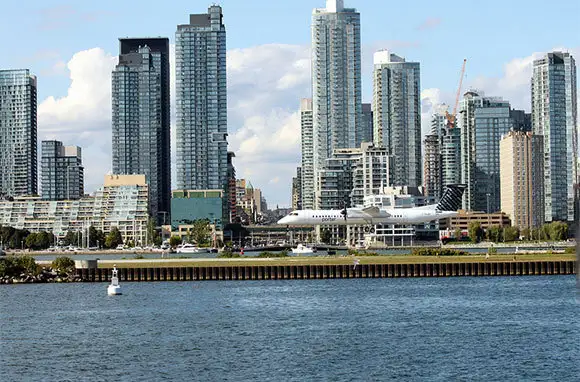
Porter: Convenience and Service in Eastern Canada
One of only four airlines in North America rated four stars by Skytrax, Porter Airlines' niche is to serve important cities in eastern Canada and the U.S. from a base at Toronto's close-in Billy Bishop Airport. (The other four-star lines in North America are Air Canada, JetBlue, and Virgin America.) Destination cities range from Thunder Bay and Chicago in the west to St John's in the east to Myrtle Beach in the south, in addition to Boston, New York, and Washington, D.C. Porter currently flies only Q400 turboprops, with seats at a generous 34-inch pitch and complementary snack and beverage service.
Billy Bishop Airport is on a lakefront island just 15 minutes by free shuttle bus from downtown Union Station. In addition to easy access, it offers the usual convenience benefits of a small airport. The main drawback for transborder travelers is the lack of U.S. preclearance, but that's currently in the works.
Porter has tentatively ordered new C-Series jets from Bombardier, which it wants to use at Billy Bishop if the city approves and agrees to extend the runway. Those larger jets would allow it to serve more remote destinations, but the idea faces NIMBY ("Not In My Back Yard") opposition.
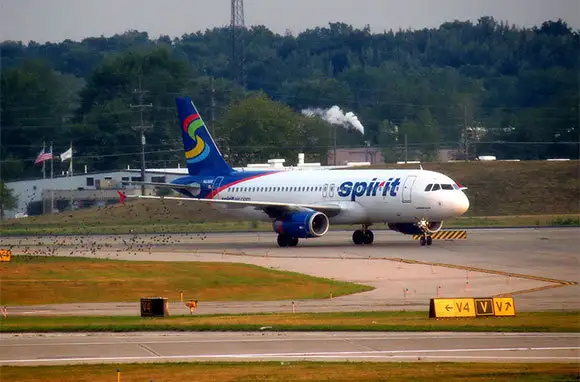
Spirit: America's Ryanair
Spirit, like Ryanair, is an airline you love to hate. It provides rock-bottom fares with rock-bottom service and a voracious appetite for fees. And as long as those fares remain rock bottom, Spirit will fill a niche that attracts lots of travelers. Spirit has not been shy to take on the giant lines: Its network includes lots of high-traffic routes flown by American, Delta, Southwest, and United, with service to many major U.S. cities, plus destinations in the Atlantic islands, Central America, Mexico, and South America as far as Lima. It operates a sort-of hub at Ft. Lauderdale and mini hubs at Dallas-Ft. Worth and Detroit, but it flies a lot of routes that don't come close to any of those points.
28-inch pitch in Spirit's A320s will crunch your knees (its 319s and 321s are a bit better). But, for many, the price is unbeatable. And you can pay extra for one of four "big front seats" in one row of the A320s and A321s and one of 10 "big front seats" in the A319s.
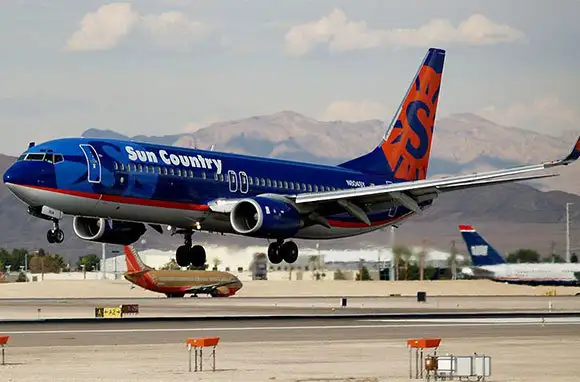
Sun Country: Midwestern Success
After a very shaky financial history, Sun Country got back to solid finances in 2009 and seems to be doing well. Its niche is hard to define: It started out as the charter affiliate of MLT Vacations, a large tour operator, but it is now a scheduled line that, while still doing a lot of charter work, seemingly operates like a conventional low-fare line.
Its primary hub is Minneapolis-St. Paul, with a smaller hub in Lansing. From these hubs, it operates year-round flights to a dozen major U.S. cities and seasonal flights to another dozen or so beach destinations in the Atlantic islands and Mexico, plus Anchorage. It also offers small 12-seat "first class" cabins in its 737s, typically sold within 24 hours of departure for $45 to $149, depending on flight length. Like Allegiant, Sun Country emphasizes hotel-air packages, but unlike Allegiant, it provides service that has won some awards.
All in all, it's hard to put a finger on exactly what Sun Country's niche is. But whatever it is, it seems to be working.
More From Smartertravel:
We hand-pick everything we recommend and select items through testing and reviews. Some products are sent to us free of charge with no incentive to offer a favorable review. We offer our unbiased opinions and do not accept compensation to review products. All items are in stock and prices are accurate at the time of publication. If you buy something through our links, we may earn a commission.
Related
Top Fares From Columbus, OH
Today's Top Travel Deals
Brought to you by ShermansTravel
Shop and Save with Country Inns...
Patricia Magaña
 Hotel & Lodging Deals
Hotel & Lodging Deals
$229 -- Chicago: Discounted Rates and...
Francesca Miele
 Hotel & Lodging Deals
$229+
Hotel & Lodging Deals
$229+
$188 -- Honolulu: Save on Oceanview...
Abigail Lamay
 Hotel & Lodging Deals
$188+
Hotel & Lodging Deals
$188+



